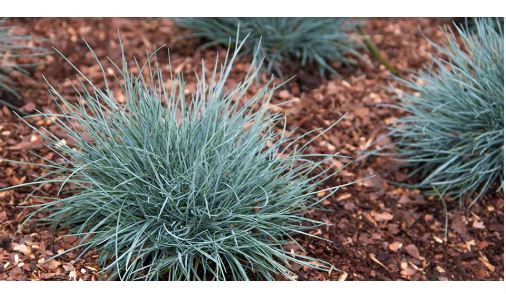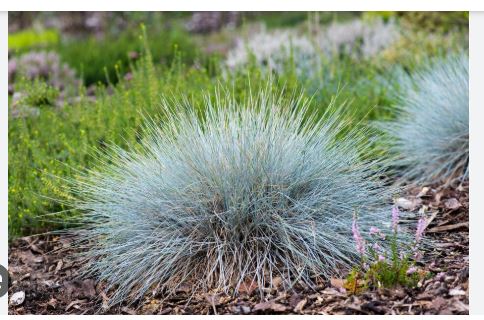
Blue Fescue (Festuca glauca) belongs to the Poaceae family, a diverse grass lineage, and is classified within the genus Festuca, which includes over 300 species of cool-season grasses. Specifically, F. glauca is a perennial bunchgrass, taxonomically distinct for its fine, needle-like leaves and compact, tufted growth habit. Its botanical name reflects its glaucous (bluish-gray) foliage, with cultivars like ‘Elijah Blue’ or ‘Boulder Blue’ refining its traits through selection rather than hybridization. Chromosomally, it’s typically diploid (2n=14), though natural variation exists across its populations, influencing vigor and adaptability.
Originating in Europe, Blue Fescue is native to mountainous and temperate regions, particularly the Alps, Pyrenees, and parts of southern France and Germany, where it thrives in rocky, well-drained soils. Fossil records and botanical surveys suggest its presence in these grasslands for millennia, adapted to cool, dry summers and harsh winters. Introduced to North America and beyond as an ornamental by the 19th century, it’s been cultivated extensively since, with modern breeding in the 20th century enhancing its color and uniformity for landscaping. Today, it’s naturalized in parts of the U.S., especially in USDA Zones 4–8.
Blue Fescue is characterized by its striking steel-blue to silvery-gray foliage, formed by narrow, rolled leaves (0.5–1 mm wide, 3–6 inches long), creating a dense, mounded clump 6–12 inches tall and wide. Its evergreen nature in milder climates (above -20°F) contrasts with tan dormancy in colder zones, while summer brings slender, feathery flower spikes (6–12 inches tall), shifting from blue-green to beige. Roots extend 6–12 inches deep, anchoring it in poor soils (pH 5.5–7.5), and its slow lateral spread (3–6 inches/year) keeps it tidy. Cultivars vary in intensity—‘Elijah Blue’ holds vivid color longest—though all fade slightly in heat above 85°F.
Uses for Blue Fescue center on ornamental landscaping, where its compact, low-maintenance form accents rock gardens, borders, and xeriscapes. Its drought tolerance (surviving on 12–20 inches rainfall/year) and fine texture pair well with succulents, lavender, or gravel mulches, enhancing visual contrast. In lawns or ground covers, it’s planted en masse (8–12 inches apart), though it’s not traffic-tolerant like turfgrasses. Beyond aesthetics, it stabilizes slopes in erosion control and offers minor forage (4–6% crude protein) in native ranges, though its tough leaves limit palatability. In containers, it thrives with minimal care, making it a versatile, year-round accent.

How To Grow And Care For Blue Fescue (Festuca glauca)
Climate and Timing
Blue Fescue thrives in USDA Zones 4–8, with optimal growth at 60°F–75°F, slowing above 85°F or below 20°F. Plant in early spring (March–April) after the last frost or early fall (September–October) when soil temperatures are 50°F–65°F, allowing roots to establish before summer heat or winter dormancy.
Site Selection
Choose a location with full sun (6–8 hours daily) to maximize its blue color, though it tolerates light shade (4–6 hours) with slightly greener hues. Ensure good air circulation to prevent fungal issues, and avoid wet, low-lying areas, as it dislikes soggy roots despite its cold tolerance to -20°F.
Soil Preparation
Blue Fescue prefers lean, well-drained soils—sandy or rocky loams—with a pH of 5.5–7.5; test and amend with sand or gravel if drainage is poor. Avoid rich, fertile soils or heavy clay, which retain water and promote rot. Till to 6–8 inches, removing weeds and rocks, but skip organic matter to mimic its native, nutrient-poor habitats.
Planting from Seed
Sow seeds (e.g., ‘Elijah Blue’) at 0.5–1 lb/1,000 sq ft in spring, broadcasting onto raked soil and pressing lightly—no deeper than 1/8 inch, as light aids germination (14–21 days at 60°F–70°F). Water gently (0.1 inch daily) until seedlings emerge (3–4 weeks), then thin to 8–12 inches apart for clumps.
Planting Divisions or Nursery Starts
For faster results, divide mature clumps (every 2–3 years) in spring or fall, ensuring each section has roots and 3–5 shoots, or use nursery plugs. Plant 8–12 inches apart, level with soil surface, and firm gently; water 0.5 inch immediately. Divisions establish in 4–6 weeks, outpacing seeds (2–3 months).
Watering During Establishment
Keep soil lightly moist (0.1–0.2 inches daily) for 4–6 weeks post-planting, using a fine mist to avoid displacing seeds or stressing roots. Transition to 0.5 inch weekly once established (6–8 weeks), tapering to rainfall dependence (12–20 inches/year) in drought-tolerant mature stands—overwatering dulls its blue hue.
Mowing and Trimming
Blue Fescue requires no regular mowing, naturally forming 6–12 inch mounds. Trim dead or faded foliage in late winter (February–March) to 2–3 inches with shears, refreshing its shape before spring growth. Remove flower spikes post-bloom (June–July) if a neat look is desired, though they add texture if left.
Fertilization
Apply minimal fertilizer—0.5–1 lb nitrogen/1,000 sq ft (e.g., 10-10-10)—once in spring at planting, avoiding excess to prevent lush, green growth that weakens its blue color. On poor soils, a light topdress (0.25 lb nitrogen) every 2–3 years suffices; water in to prevent burn. Over-fertilizing softens its tough, wiry texture.
Irrigation Maintenance
Once established, water only during prolonged drought (2–3 weeks without rain), providing 0.5–1 inch every 10–14 days in summer heat (above 90°F). Use drip irrigation or soak soil morning hours to keep foliage dry, minimizing rust risk. In wet climates, its drainage needs may require raised beds.
Weed Control
Hand-pull weeds during establishment (first 6–12 months), as young fescue competes poorly; mature clumps suppress weeds naturally via density. Pre-emergent herbicides (e.g., prodiamine) in spring can prevent annual grasses, but avoid broadleaf chemicals post-emergence—Blue Fescue’s fine leaves risk damage. Mulch with gravel (1–2 inches) to deter weeds and retain its rocky aesthetic.
Pest and Disease Management
Blue Fescue resists most pests, but watch for rust (orange spots) in humid summers—improve airflow and avoid overhead watering; fungicides (e.g., myclobutanil) are rarely needed. Aphids or mites (yellowing leaves) are uncommon but treatable with insecticidal soap if spotted in July–August. Healthy drainage prevents root rot, its main threat.
Division and Propagation
Divide overcrowded clumps every 2–3 years in spring or fall to maintain vigor, lifting with a spade and separating into 4–6 inch sections. Replant immediately or pot for gifts; water well post-division. Self-seeding occurs minimally—collect ripe seeds (July) from flowerheads for controlled sowing, though cultivars may not breed true.
Winter Care
In Zones 4–6, Blue Fescue stays semi-evergreen; mulch lightly (1 inch straw or gravel) in late fall if bare soil risks frost heaving. In milder Zones 7–8, it remains green year-round with no extra care. Avoid heavy, wet mulch like bark, which traps moisture and promotes crown rot in winter thaws.
Pros & Cons of Growing Blue Fescue (Festuca glauca)
Pros of Growing Blue Fescue
- Stunning Aesthetic Appeal
Blue Fescue’s steel-blue to silvery-gray foliage forms neat, compact mounds (6–12 inches), providing a bold color contrast in rock gardens, borders, or mixed plantings. Its fine, needle-like leaves and feathery summer flower spikes enhance visual texture, making it a standout accent alongside green shrubs or purple blooms like lavender. - Drought Tolerance
Once established (6–8 weeks), Blue Fescue thrives on minimal water—12–20 inches of rainfall annually or 0.5–1 inch every 2 weeks in drought—outperforming thirstier grasses like bentgrass (1–1.5 inches/week). Its deep roots (6–12 inches) and waxy leaves adapt to arid conditions, ideal for xeriscaping or low-water regions. - Low Maintenance
Requiring no regular mowing, Blue Fescue needs only an annual trim (to 2–3 inches in late winter) to refresh its shape, unlike turfgrasses demanding weekly cuts. Fertilizer needs are minimal (0.5–1 lb nitrogen/1,000 sq ft every 2–3 years), and its slow spread (3–6 inches/year) keeps it contained, reducing upkeep costs and effort. - Cold Hardiness
Hardy to Zone 4 (-20°F to -30°F), Blue Fescue withstands harsh winters, remaining semi-evergreen in milder climates (Zones 7–8) or rebounding reliably from dormancy in spring. This resilience surpasses warm-season grasses like buffalograss, which struggle below Zone 5, making it versatile for northern gardens. - Erosion Control and Weed Suppression
Its dense, tufted growth stabilizes soil on slopes or rocky terrain, preventing runoff in low-fertility sites where it’s native. Mature clumps (after 1–2 years) crowd out weeds naturally, reducing herbicide use compared to sparse grasses like ryegrass, enhancing its ecological value in naturalistic settings.
Cons of Growing Blue Fescue
- Slow Establishment
From seed, Blue Fescue takes 2–3 months to form a decent stand (germination in 14–21 days, full coverage in 1–2 seasons), lagging behind ryegrass (4–6 weeks). Divisions or plugs speed this to 6–12 weeks, but its slow lateral spread (3–6 inches/year) delays large-scale coverage, testing patience for ground cover projects. - Poor Traffic Tolerance
Unlike wear-resistant bentgrass or zoysiagrass, Blue Fescue’s fine, brittle leaves and shallow roots (6–12 inches) bruise under foot traffic, making it unsuitable for lawns or play areas. Heavy use flattens its mounds, requiring replanting or protection, limiting its functional range. - Shade Intolerance
Requiring full sun (6–8 hours) for optimal blue color, Blue Fescue fades to green and thins in shade (below 4 hours), unlike shade-tolerant zoysiagrass or fescue cousins. This restricts its use under trees or in north-facing yards, demanding careful site selection or supplemental clearing. - Heat Sensitivity
Above 85°F, Blue Fescue’s color dulls, growth slows, and clumps may die back, necessitating extra water (0.5–1 inch/week) to survive summer heat—unlike buffalograss, which thrives at 110°F. In hot climates (Zones 9+), it struggles without cooling microclimates, reducing its appeal in southern regions. - Limited Lifespan and Division Needs
Individual clumps live 3–5 years before center die-out, requiring division every 2–3 years to maintain vigor—a task more frequent than zoysiagrass (5–10 years). Without this, its tidy form degrades, and replacement costs rise, especially for cultivars like ‘Elijah Blue’ that don’t self-seed true.